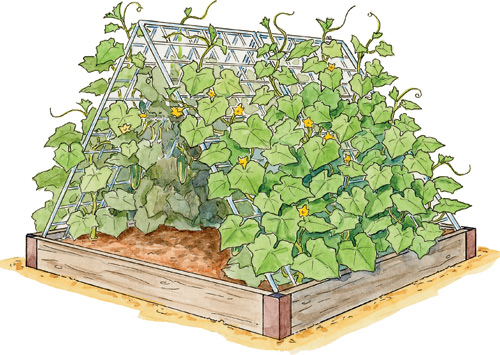If you don’t have the space in your home to plant vegetables, you can grow them in containers. Cucumber are one example. Annual, herbaceous plant, they belong to the same family as zucchini, melon and watermelon, it is characterized by long stems that creep or climb and reach up to 3 meters.
Growing cucumbers is medium difficult and with proper care can give you a decent harvest. Here are some tips on how to do it:
Most well-known varieties of cucumber
The varieties and hybrids of cucumber are divided into large-fruited varieties and small-fruited ones. A traditional long-fruited variety of cucumber is the Kalivian cucumber, suitable for summer outdoor cultivation that gives very tasty smooth dark green fruits, about 40 cm long.
From the small-fruited varieties – the Knossos variety, from the area of Heraklion, Crete, with a smooth dark green crispy fruit about 20 cm long. Most cucumber varieties are harvested 2 months after transplanting the young plants. A common production of a cucumber plant can reach 20-40 cucumbers in 1-2 months after planting depending on the variety.
When to plant cucumbers
If you want to plant early, in March-April, before the weather warms up enough, you must prepare the seed pods in a vegetable greenhouse and transplant them after about a month as soon as they are ready. If the cucumber is planted at a later time, during the May-June period when the temperature has risen to 20-25 ° C, you can plant the cucumber seed directly in the ground. In this case, the plant takes root directly in the soil, adapted, better to environmental conditions and will not be “stressed” due to transplanting. Plant the cucumber plants at the appropriate planting distances, every 50-70 cm between sites and 1.50-1.70 meters between planting lines, facilitating creeping vegetation. This helps to better ventilate and illuminate the plants and reduce fungal and entomological diseases.
Support
The cucumber does not need to be supported, as it can grow and bear fruit, crawling on the ground. If we want to support the plants to save space, the cucumbers can be elevated with twine as it is done in greenhouses or in pots on our balcony. In the garden, you can build a special grid with an angle of 45 degrees, made of stainless steel or reeds. In this case, if the cucumber is supported and does not fall to the ground, you can achieve better ventilation of the plant and avoid the development of various fungal diseases.
Watering
Cucumber needs much water in order to have good growth and significant fruiting. Watering is needed every two to three days during the spring and every one or two days during the summer, so that the soil is kept moist during the growing season. Also, it is important to mention that cucumber needs watering with good quality water, as it is sensitive to the high content of irrigation water, but also the soil, in salts.
Compost
Initially, before transplanting the cucumber, incorporate organic matter into the planting sites in the form of compost and well-digested manure. At the same time, add a complete organic fertilizer every three weeks to help the vigor, the vegetative growth of the plants, the flowering and the production of fruits. Cultivation of cucumber is demanding on nitrogen and potassium, as well as magnesium.
See also: How to prune cucumbers to avoid disease and have a rich harvest
Diseases and insects
Cucumbers are affected by various diseases and insects that infect the foliage, shoots and flowers. A particularly important problem in the cultivation of cucumber is the fungus of powdery mildew that causes whitening on the leaves and also creates a problem on the fruits. Also, cucumber is affected by the moth that dries its leaves during the summer and degrades its fruits. To deal with them, dust with sulfur around the root, so that the fumes during the hot days provide protection for the powdery mildew and the blackhead. You can also use an improvised solution to prevent spoilage by dissolving one tablespoon of baking soda and 2 tablespoons of olive oil in 2 liters of water.
Cucumber is also very often affected by the insects of the meligra and the floury, which create honeydew and then the tobacco fungus that darkens the leaves develops, as well as by the insect of the thrips. To treat cucumber insects, spray their foliage every 2 weeks with potassium salts supplied by agricultural shops, as well as with natural pyrethrin to protect them from thrips. The recipe with natural ingredients you can try yourselves consists of dissolving a tablespoon of grated green soap and 1 tablespoon of alcohol in a liter of water and spraying the leaves of cucumber plants every week.
Propagation
To create new cucumber plants, the best way to propagate them is by seed. Choose varieties of cucumber (not hybrids), as they have separate female and male flowers and produce fruits with seeds. It should be noted that the hybrids have only female flowers and produce virgin fruit, without seeds whenever we can not cultivate next year. In the case of hybrids, we must procure new seeds or ready-made cucumber plants from nurseries every year.
Bitter taste cause
In some varieties the cucumber fruit is bitter due to dry thermal conditions or sudden changes in temperature and humidity. Many old growers mistakenly believed that the bitterness was due to the accidental pressing of small cucumber fruits in the ground.
Source: mydesiredhome.com

